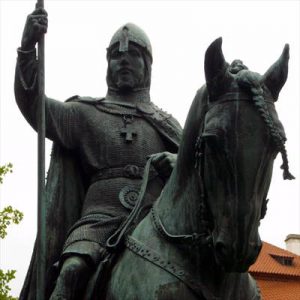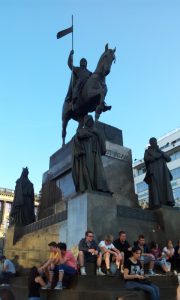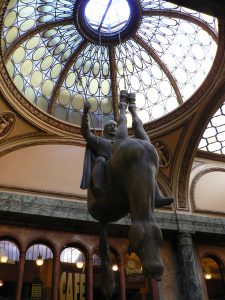Saint Wenceslas (Václav): The Czech nation’s patron saint
By Tracy A. Burns
Good Duke Wenceslas
 The first Czech saint and the patron saint of the Czech state, Wenceslas (Václav in Czech) served as duke of Bohemia from 921 until his death in 929 or 935. Though he died young, this martyr’s accomplishments were many. He built numerous churches in Bohemia and was deeply respected as a pious, moral, educated, and intelligent man who promoted the Christian faith and took care of the poor, the sick, the widowed, and the orphaned by doing charitable deeds. He even founded the rotunda of Saint Vitus at Prague Castle.
The first Czech saint and the patron saint of the Czech state, Wenceslas (Václav in Czech) served as duke of Bohemia from 921 until his death in 929 or 935. Though he died young, this martyr’s accomplishments were many. He built numerous churches in Bohemia and was deeply respected as a pious, moral, educated, and intelligent man who promoted the Christian faith and took care of the poor, the sick, the widowed, and the orphaned by doing charitable deeds. He even founded the rotunda of Saint Vitus at Prague Castle.
His childhood and early adulthood
Born in 907, Wenceslas was a member of the Přemysl dynasty that would rule Bohemia from the ninth century to 1306. His father was the founder of the Přemyslids, Bořivoj I, the duke of Bohemia from 870 to 889 who installed Christian values in his son. Wenceslas’ mother, Drahomíra, came from a pagan background but was baptized when she married Bořivoj, according to some sources. Still, in many legends, she fervently clung to her pagan roots. Wenceslas was an impressionable 13 years old when his father died, and then it was his grandmother Ludmila’s turn to raise him. However, Drahomíra argued with Christian subjects and aspired to gain recognition from the nobility. Because Ludmila had encouraged Wenceslas in Christian beliefs, Drahomíra had Ludmila killed on September 15, 921, and Ludmila became a saint. Drahomíra decided it was high time her son became a pagan, but she found it impossible to persuade Wenceslas. In fact, during 924 or 925, Wenceslas sent her out of the country.
Threats from Saxony and Bavaria
After Wenceslas took over the government at age 18, he scored an impressive victory against the rebel duke of Kouřim, Radislav. Ever since the Great Moravian Empire had been destroyed in 902, Saxon duke and East Frankish King Henry the Fowler (Jindřich I. Ptáčník) had posed a threat to the Czech lands, so his relationship with Bohemia was of great significance. When Henry the Fowler took office, he gave many privileges to Bavarian duke Arnulf the Bad. The Saxon duke expanded his territory, threatening Bohemia even more. Wenceslas longed for the Czech principality to become independent.
Coming to terms with King Henry the Fowler
Alas, it was not to be. The Saxons and Bavarians attacked Bohemia unexpectedly, easily making their way to Prague. It is not certain why the two forces attacked the Czechs, but it was possibly because Bohemia made up an anti-Saxon alliance, along with the Polabian Slavs and Magyars. In response to the attacks, Wenceslas negotiated a treaty, which stated that he had to pay a yearly tribute of silver and oxen. As long as he paid this fee, Wenceslas was able to concentrate on strengthening the Czech state and spreading the Christian faith within his principality. His relationship with Henry the Fowler improved, and King Henry the Fowler even gave Wenceslas the remains of Saint Vitus. Wenceslas built a rotunda consecrated to Saint Vitus at Prague Castle, and it became the main religious institution in Bohemia.
Death
His brother Boleslav the Cruel invited Wenceslas to his seat in Stará Boleslav to celebrate either the feast of Saint Michael or the feast of Saints Damian and Cosmas (sources differ), when fate intervened. On Wenceslas’ second day in town, he was walking to morning mass when he ran into Boleslav and had an argument with him. Boleslav hit him on the head with his sword, causing only a slight injury. Still, Wenceslas did not stick up for himself because he did not want to fight his own brother. Boleslav ordered his retinue to kill Wenceslas, which they did, on September 28, either in 935 or 929, though contemporary historians tend to prefer 935. His remains are in the Saint Wenceslas Chapel at Saint Vitus Cathedral of Prague Castle. The story of his life and death was painted on the chapel walls in the early 16th century. Master 14th century Czech sculptor Petr Parléř decorated the shrine. Wenceslas’ helmet and armor can be found at Prague Castle, too.
The King and the Saint in Literature
Wenceslas was destined for sainthood immediately after his death. Although Wenceslas was a duke during his lifetime, Holy Roman Emperor Otto I gave the pious Přemyslid the status of king posthumously. Even as far back as the 10th century, people revered Wenceslas, who became the subject of many legends, including two of the first Old Slavonic tales. The late leader who excelled at riding horses is also a major player in the Kosmas Chronicle, the Gumpold Legend, and the Vyšehrad Codex. The Dalimal Chronicle from the early 14th century recounts the legend of his life and death, too. A cult promoting Wenceslas flourished by the second half of the 11th century and even spread to Russia. He is not only the symbol of the Czech state but also the only Czech saint whose name day appears on the worldwide Roman Catholic calendar.
Coins and monuments
The story of Wenceslas was not only celebrated in literature. His image has appeared on coins as well. Nowadays, his likeness appears on the 20 crown coin. Perhaps the most well-known memorial to Wenceslas is his monument on Prague’s Wenceslas Square, where he is flanked by saints Adalbert (Vojtěch), Ludmila, Prokop, and Agnes (Aněžka). In Stará Boleslav a basilica was named after him. The Saint Wenceslas Cathedral stands on Wenceslas Square in Olomouc.
Saint Wenceslas in Czech art
His persona is portrayed often in Czech art as well. The Saint Wenceslas story is expertly painted on the walls of the entranceway to the remarkable Chapel of the Holy Cross at Karlštejn Castle near Prague and on the Mister of Litoměřice altar. He is also celebrated in lunettes at the Church of Saint Wenceslas of Zderaz in Prague’s New Town. The murdered martyr is portrayed on horseback in Saint Prokop Church in the Žižkov district of the capital. During the Baroque era many painters, including master Karel Škréta, depicted Saint Wenceslas, and his image decorates many Baroque churches. The legendary ruler is also often portrayed on plague columns, too.
Saint Wenceslas in the 19th century
 During the 19th century, the cult of Saint Wenceslas was one of the most passionate themes taken up during the Czech Nationalist Revival, which intended to bring the Czech language, culture, and national identity back to life. Renowned Czech sculptor Josef Václav Myslbek finished the statue on Wenceslas Square in 1913 after a 20-year process. Films about the saint’s life were made in 1929 and 1994, for instance.
During the 19th century, the cult of Saint Wenceslas was one of the most passionate themes taken up during the Czech Nationalist Revival, which intended to bring the Czech language, culture, and national identity back to life. Renowned Czech sculptor Josef Václav Myslbek finished the statue on Wenceslas Square in 1913 after a 20-year process. Films about the saint’s life were made in 1929 and 1994, for instance.
Saint Wenceslas in songs: “Good King Wenceslas”
The Christian leader is also celebrated in songs. The hymn “Saint Wenceslas Chorale,” dating as far back as the 12th century, was even considered a possibility for the national anthem when Czechoslovakia was born in 1918. The Saint Stephen’s Day (December 26) carol “Good King Wenceslas” was written in 1853, inspired by Wenceslas’ image as a righteous king.
Abuse of Saint Wenceslas’ image during the Protectorate
During the Nazi Protectorate, Saint Wenceslas’ image was abused. Wenceslas appeared on horseback on the 5,000 bill, and the Saint Wenceslas eagle served as the greatest distinction the protectorate could give a Czech who collaborated with the Nazis.
Saint Wenceslas from the 1990s to the year 2000
 Since 1994 Saint Wenceslas has also been the patron saint of the Boy Scouts because he forgave Boleslav for his deadly deed. In 1999 sculptor David Černý created “Horse,” which depicts Saint Wenceslas sitting upside-down on a dead horse. The artwork is located in the Lucerna passage of downtown Prague. Since 2000 Wenceslas’ name day of September 28 is a national holiday called Czech Statehood Day.
Since 1994 Saint Wenceslas has also been the patron saint of the Boy Scouts because he forgave Boleslav for his deadly deed. In 1999 sculptor David Černý created “Horse,” which depicts Saint Wenceslas sitting upside-down on a dead horse. The artwork is located in the Lucerna passage of downtown Prague. Since 2000 Wenceslas’ name day of September 28 is a national holiday called Czech Statehood Day.



